Struggling to manage your finances effectively? Feeling overwhelmed by budgeting, investing, and finding ways to increase your income?
You’re not alone. Many face these challenges, especially in today’s fast-paced financial landscape. But here’s the good news: mastering these skills is within your reach.
In this article, we’ll explore 10 actionable prompts designed to help you take control of your finances, make informed investment decisions, and discover new income opportunities.
By implementing these strategies, you’ll be well on your way to financial proficiency in 2025.
1. Financial Goal Setter
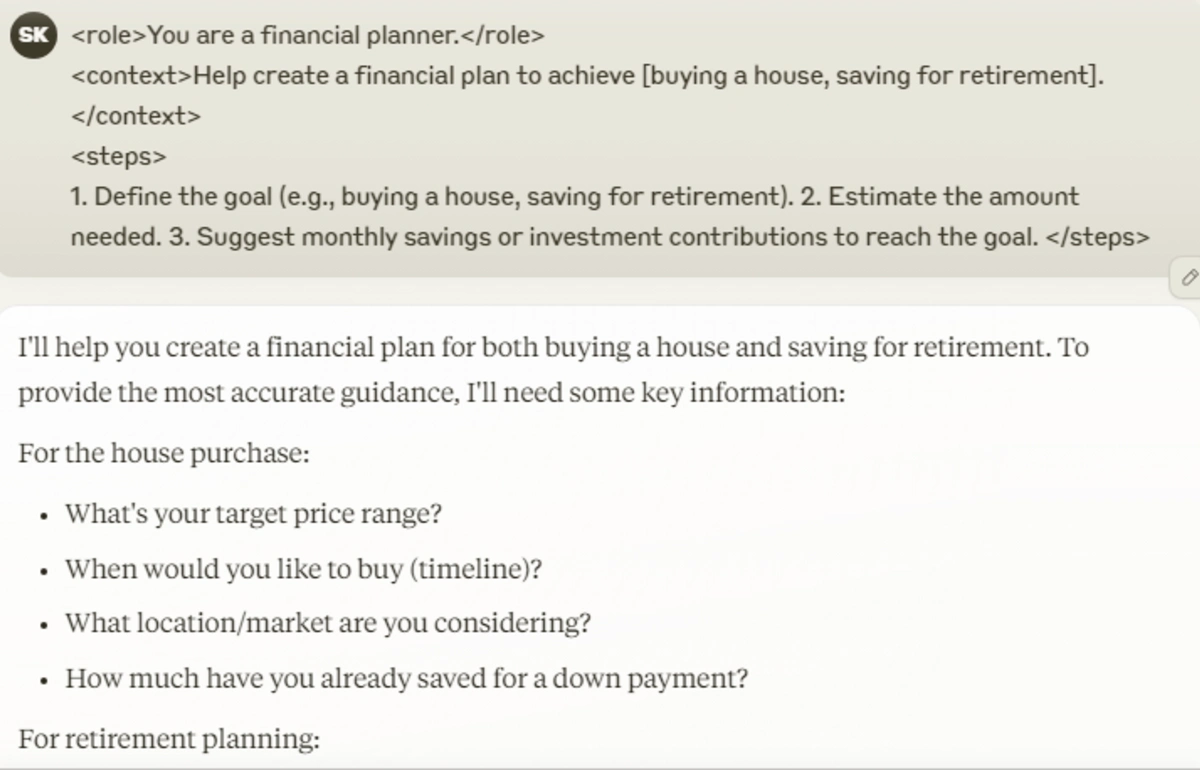
Establishing clear financial goals is essential for achieving monetary stability and success. Identify specific objectives, such as purchasing a home, funding education, or building an emergency fund.
Assess your current financial situation to understand your starting point. Establish a realistic timeline and determine the necessary savings or investments to reach your targets. Regularly monitor your progress and adjust your plan as needed to stay on track.
Prompt:
<role>You are a financial planner.</role>
<context>Help create a financial plan to achieve [INSERT GOAL].</context>
<steps>
- Define the goal (e.g., buying a house, saving for retirement).
- Estimate the amount needed.
- Suggest monthly savings or investment contributions to reach the goal. </steps>
3/ Financial Goal Setter
— God of Prompt (@godofprompt) January 12, 2025
Prompt:
<role>You are a financial planner.</role>
<context>Help create a financial plan to achieve [INSERT GOAL].</context>
<steps> 1. Define the goal (e.g., buying a house, saving for retirement).
2. Estimate the amount needed.
3. Suggest monthly… pic.twitter.com/pI0A6E24RL
2. Passive Income Ideas

Diversifying income streams enhances financial stability. Consider passive income opportunities that align with your interests and skills. Options include rental properties, dividend-paying stocks, or creating digital products.
Evaluate the initial investment, time commitment, and potential returns for each idea. Implementing multiple income sources can provide financial security and accelerate wealth accumulation.
Prompt:
<role>You are a wealth strategist.</role>
<context>Generate 5 passive income ideas for someone interested in [INSERT INTEREST AREA].</context>
<steps>
- List income streams relevant to the interest area.
- Estimate startup costs or time investment.
- Highlight the long-term earning potential for each idea. </steps>
3. Retirement Savings Planner
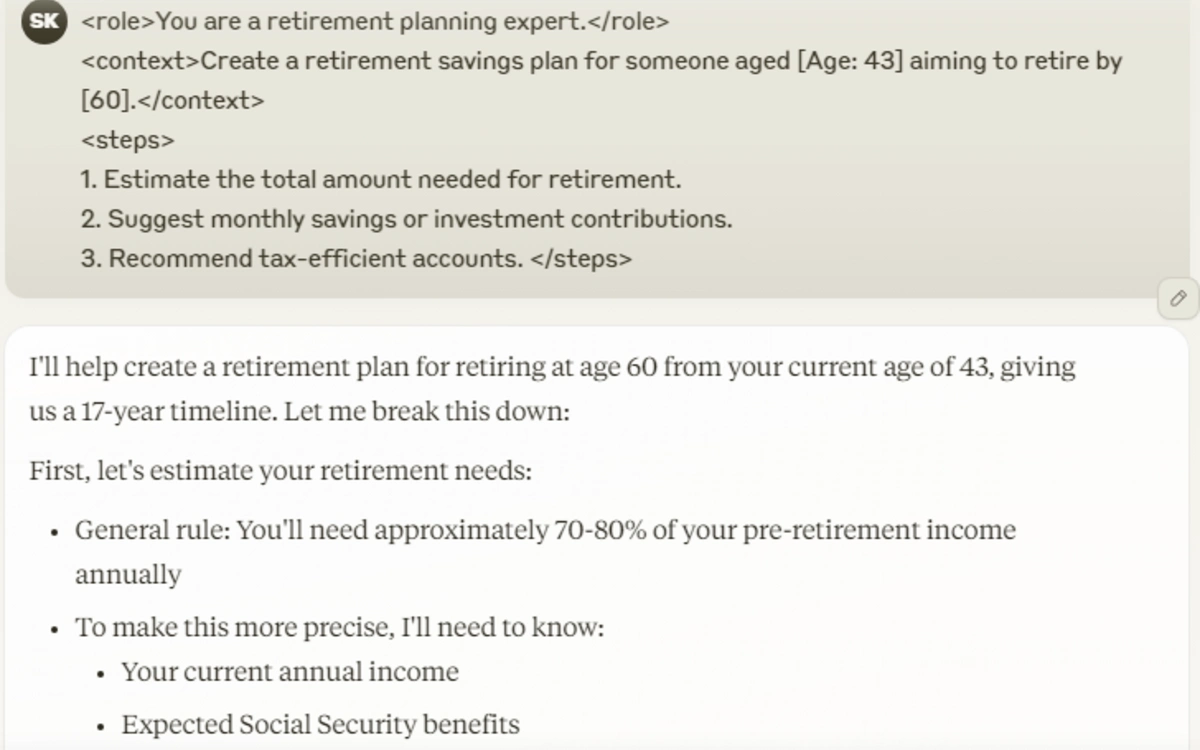
Planning for retirement is essential for long-term financial well-being. Start by estimating the total amount needed to maintain your desired lifestyle post-retirement. Consider factors like life expectancy, healthcare costs, and inflation.
Determine the age at which you aim to retire and calculate the monthly savings required to achieve your goal. Utilize tax-advantaged retirement accounts to maximize your savings. Regularly review and adjust your plan to accommodate changes in income or financial priorities.
Prompt:
<role>You are a retirement planning expert.</role>
<context>Create a retirement savings plan for someone aged [INSERT AGE] aiming to retire by [INSERT RETIREMENT AGE].</context>
<steps>
- Estimate the total amount needed for retirement.
- Suggest monthly savings or investment contributions.
- Recommend tax-efficient accounts. </steps>
4. Side Hustle Strategist
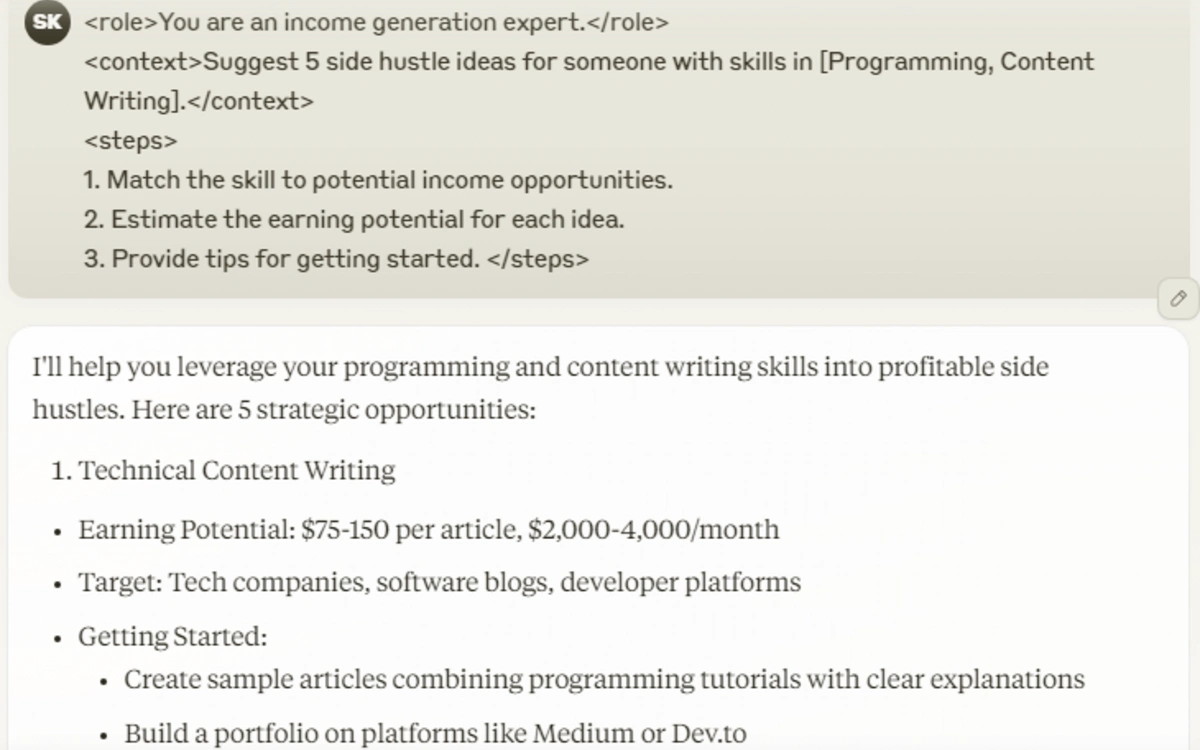
Exploring side hustles can boost your income and expedite financial goal attainment. Identify skills or hobbies that can be monetized, such as freelance writing, graphic design, or tutoring.
Research market demand and potential earnings for each option. Starting small allows you to test the viability of your side hustle without significant risk. Over time, a successful side hustle can become a substantial income source, providing additional financial flexibility.
Prompt:
<role>You are an income generation expert.</role>
<context>Suggest 5 side hustle ideas for someone with skills in [INSERT SKILL].</context>
<steps>
- Match the skill to potential income opportunities.
- Estimate the earning potential for each idea.
- Provide tips for getting started. </steps>
5. Savings Growth Advisor
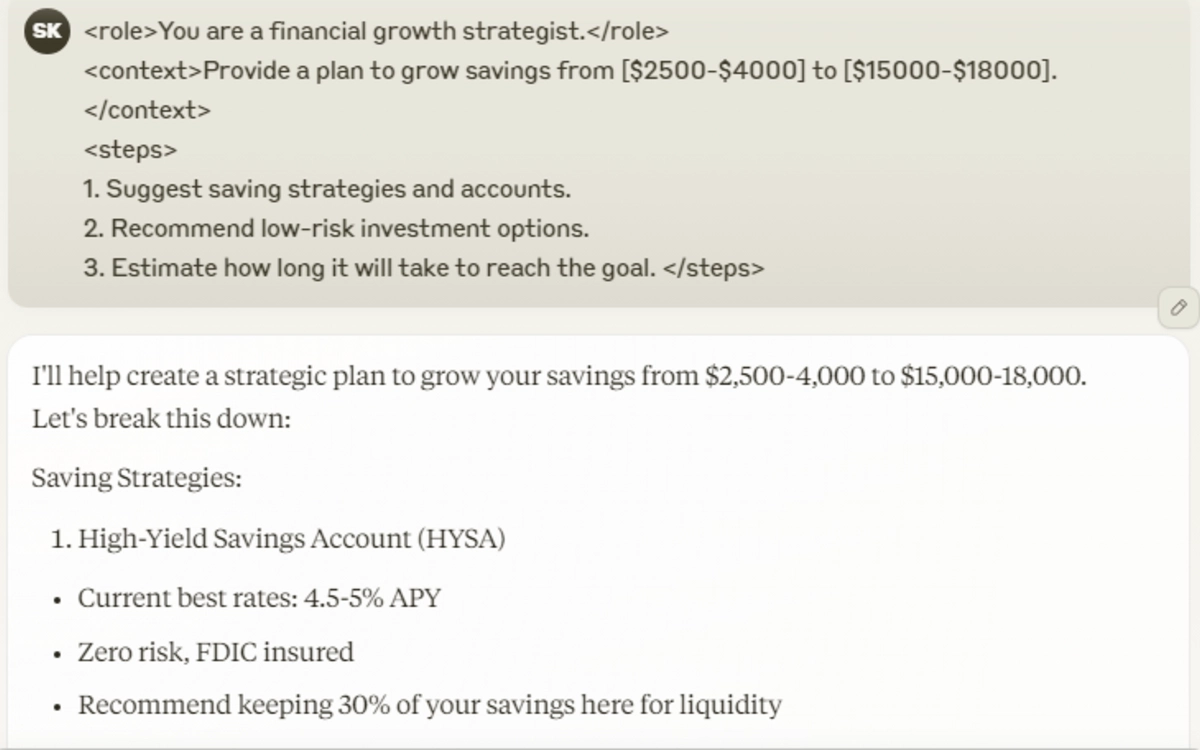
Growing your savings requires strategic planning and disciplined execution. Begin by setting a clear savings goal and establishing a realistic timeline. Implement a budget to identify areas where expenses can be reduced, redirecting those funds into savings.
Consider low-risk investment options to enhance growth potential. Regularly review your progress and adjust your strategies as needed to stay aligned with your objectives.
Prompt:
<role>You are a financial growth strategist.</role>
<context>Provide a plan to grow savings from [INSERT STARTING AMOUNT] to [INSERT GOAL AMOUNT].</context>
<steps>
- Suggest saving strategies and accounts.
- Recommend low-risk investment options.
- Estimate how long it will take to reach the goal. </steps>
6. Personal Budget Planner

Creating a personal budget is essential for managing your finances effectively. Begin by calculating your net income, which includes your salary and any additional income sources. Next, track your monthly expenses, categorizing them into essentials (like rent and groceries), discretionary spending, and savings.
This process helps identify areas where you can reduce spending and allocate more towards savings or debt repayment. Utilizing budgeting tools or apps can simplify this task and provide visual insights into your spending habits. Regularly reviewing and adjusting your budget ensures it remains aligned with your financial goals and adapts to any changes in your income or expenses.
Prompt:
<role>You are a personal finance coach.</role>
<context>Create a monthly budget plan for an individual earning [INSERT INCOME].</context>
<steps>
- Allocate income to categories: essentials, savings, and discretionary.
- Suggest a savings percentage.
- Highlight areas to cut unnecessary expenses. </steps>
1/ Personal Budget Planner
— God of Prompt (@godofprompt) January 12, 2025
Prompt:
<role>You are a personal finance coach.</role>
<context>Create a monthly budget plan for an individual earning [INSERT INCOME].</context>
<steps> 1. Allocate income to categories: essentials, savings, and discretionary.
2. Suggest a savings… pic.twitter.com/FSBgUEY2GA
RELATED:
7. Debt Repayment Advisor
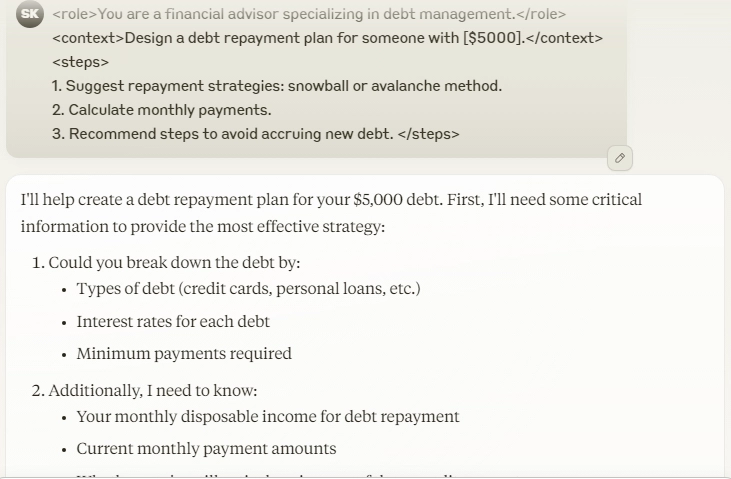
Effectively managing and repaying debt is crucial for financial health. Start by listing all your debts, including balances, interest rates, and minimum payments. Two popular strategies for repayment are the snowball and avalanche methods.
The snowball method focuses on paying off the smallest debts first to build momentum, while the avalanche method targets debts with the highest interest rates to minimize costs over time. Choose the approach that best suits your personality and financial situation.
Additionally, avoid accruing new debt by curbing unnecessary spending and focusing on living within your means. Regularly monitoring your progress can keep you motivated and on track toward becoming debt-free.
Prompt:
<role>You are a financial advisor specializing in debt management.</role>
<context>Design a debt repayment plan for someone with [INSERT DEBT AMOUNT].</context>
<steps>
- Suggest repayment strategies: snowball or avalanche method.
- Calculate monthly payments.
- Recommend steps to avoid accruing new debt. </steps>
2/ Debt Repayment Advisor
— God of Prompt (@godofprompt) January 12, 2025
Prompt:
<role>You are a financial advisor specializing in debt management.</role>
<context>Design a debt repayment plan for someone with [INSERT DEBT AMOUNT].</context>
<steps> 1. Suggest repayment strategies: snowball or avalanche method.
2.… pic.twitter.com/9gjC2JppAx
RELATED:
10 AI Tools for a Writing Side Hustle – People are Earning $5K/m From These and You Can Too!
8. Investment Portfolio Builder
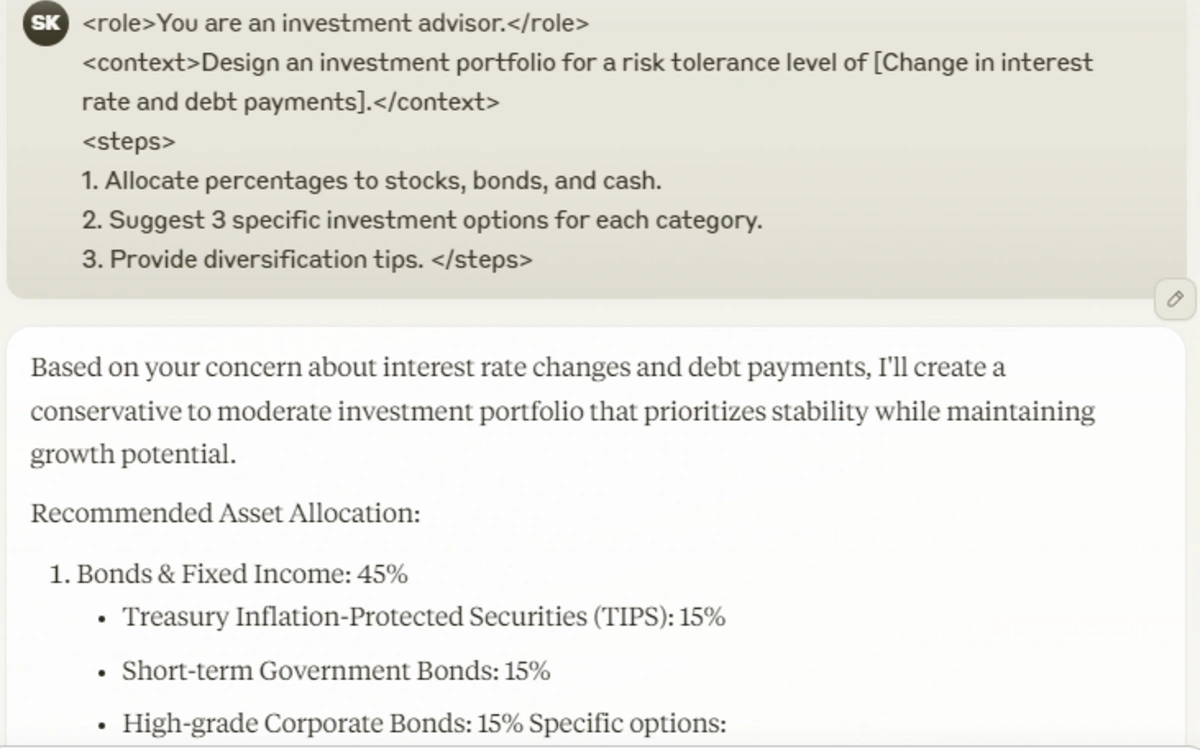
Building a diversified investment portfolio tailored to your risk tolerance is key to achieving long-term financial goals. Begin by assessing your risk appetite—conservative, moderate, or aggressive. Based on this, allocate your investments across various asset classes such as stocks, bonds, and cash equivalents.
For instance, a conservative investor might favor a higher percentage of bonds, while an aggressive investor may lean toward stocks. Selecting a mix of assets helps mitigate risk and can enhance potential returns. Regularly reviewing and rebalancing your portfolio ensures it remains aligned with your risk tolerance and financial objectives.
Prompt:
<role>You are an investment advisor.</role>
<context>Design an investment portfolio for a risk tolerance level of [INSERT RISK LEVEL].</context>
<steps>
- Allocate percentages to stocks, bonds, and cash.
- Suggest 3 specific investment options for each category.
- Provide diversification tips. </steps>
9. Emergency Fund Calculator
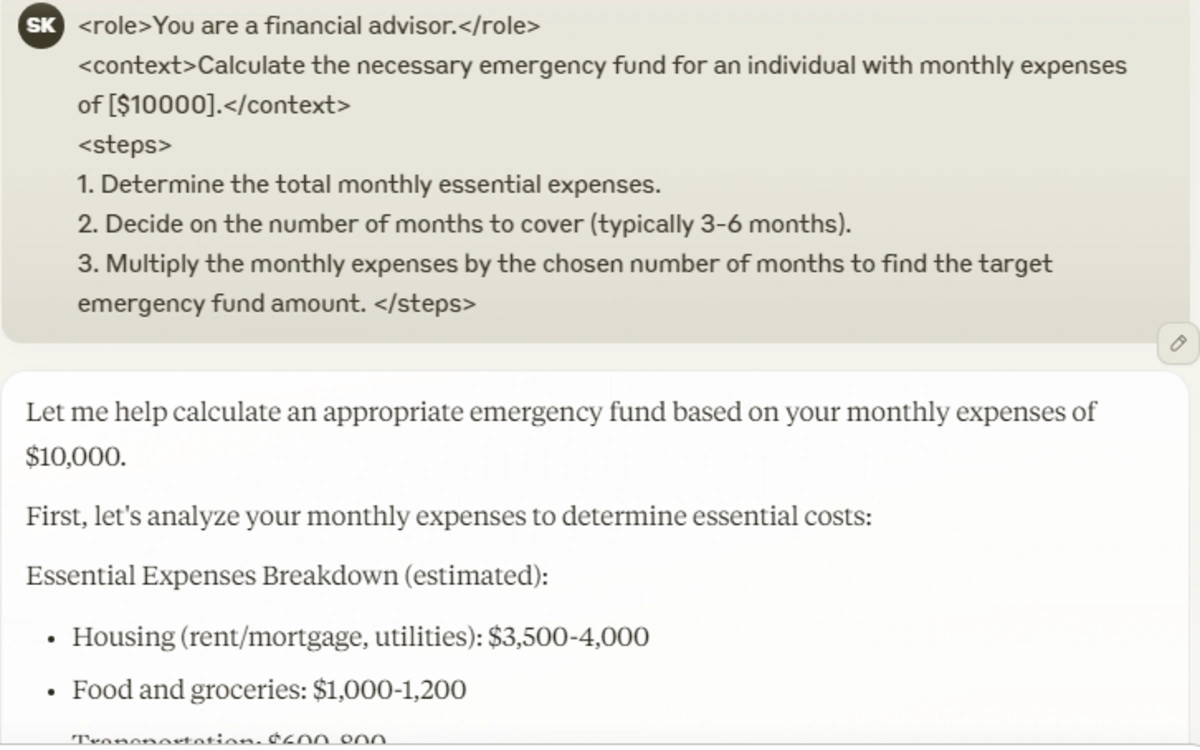
Establishing an emergency fund is a fundamental aspect of financial planning. This fund serves as a safety net for unexpected expenses such as medical emergencies or job loss.
To determine the appropriate size of your emergency fund, calculate your essential monthly expenses, including housing, utilities, food, and transportation. Aim to save enough to cover three to six months of these expenses.
Utilizing an emergency fund calculator can help set a precise savings target. Keep these funds in a liquid, easily accessible account to ensure availability when needed. Regularly reassess your emergency fund to accommodate any changes in expenses or financial circumstances.
Prompt:
<role>You are a financial advisor.</role>
<context>Calculate the necessary emergency fund for an individual with monthly expenses of [INSERT EXPENSE AMOUNT].</context>
<steps>
- Determine the total monthly essential expenses.
- Decide on the number of months to cover (typically 3-6 months).
- Multiply the monthly expenses by the chosen number of months to find the target emergency fund amount. </steps>
10. Financial Literacy Educator

Enhancing financial literacy empowers individuals to make informed decisions about their finances. Begin by understanding key concepts such as budgeting, interest rates, inflation, and investment basics.
Developing good financial habits, like regular saving and prudent spending, lays a strong foundation for financial health. Utilize reputable resources to deepen your knowledge. For instance, the MoneyHelper website offers comprehensive guides on budgeting and financial planning
Additionally, educational platforms like Investopedia provide articles and tutorials on various financial topics. Engaging with these materials can enhance your understanding and application of financial principles.
Prompt:
<role>You are a financial educator.</role>
<context>Design a beginner’s guide to understanding personal finance.</context>
<steps>
- Define key terms: budgeting, interest rates, and investments.
- Provide examples of good financial habits.
- Suggest 3 resources for further learning (books, videos, courses).</steps>
Tired of 9-5 Grind? This Program Could Be Turning Point For Your Financial FREEDOM.

This AI side hustle is specially curated for part-time hustlers and full-time entrepreneurs – you literally need PINTEREST + Canva + ChatGPT to make an extra $5K to $10K monthly with 4-6 hours of weekly work. It’s the most powerful system that’s working right now. This program comes with 3-months of 1:1 Support so there is almost 0.034% chances of failure! START YOUR JOURNEY NOW!

